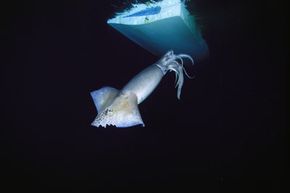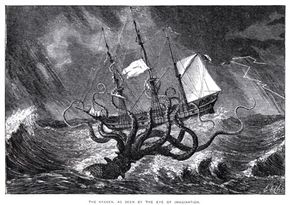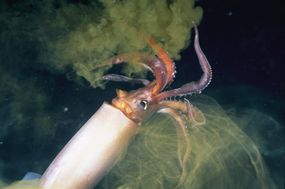About 300 different species of squid have been swimming in the world's oceans for more than 400 million years [source: National Wildlife Federation]. They caught human interest from the moment one tentacle was seen -- interest that was especially intense when that tentacle was nearly 20 feet (6 meters) long.
Gigantic, powerful squid have been legendary for ages. There are three species that grow to massive proportions: the giant (Architeuthis dux), the colossal (Mesonychoteuthis hamiltoni) and the jumbo, also known as Humboldt (Dosidicus gigas).
Advertisement
While many squid are a few inches long, giant and colossal squid are enormous. The two types are estimated to grow from 35 to 60 feet (10.6 to 18.2 meters) in length -- including body and tentacles. That's larger than a full-length, 40-foot (12.1-meter) school bus. They weigh up to 1,000 pounds (453.5 kg) [source: Smithsonian Institution]. And they have protruding eyes the size of volleyballs. Humboldt squid are the smallest of the three, about 6 to 7 feet (1.8 to 2.1 meters) long and 100 pounds (45.3 kg).
How do these marine animals get so big? The most common explanation is a phenomenon called deep-sea gigantism. The theory suggests that over time, small shallow-water creatures evolved to live at vast deep-sea levels by getting bigger -- likely due to a combination of food supply and the increased size of the predators at great depths. In shallow waters it's advantageous to stay small because there's limited food. But at the extreme depths where massive squid are thought to live, roughly 650 to 2,600 feet (200 to 700 meters) below the surface, bigger creatures have size and endurance on their side when traveling longer distances in search of food. When you're a small fish in a large pond, you're a snack, but if you're the big fish, you have your choice of snacks.
So when you're this massive, is the world your buffet? Could a squid of these proportions even take down a submarine? Let's find out, next.
Advertisement




